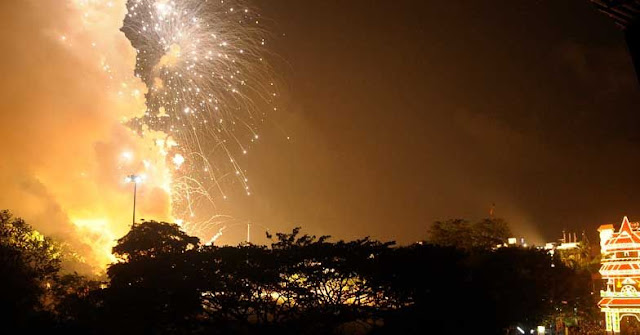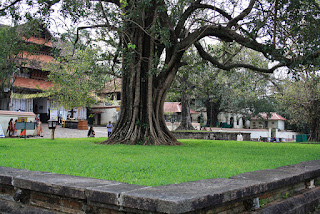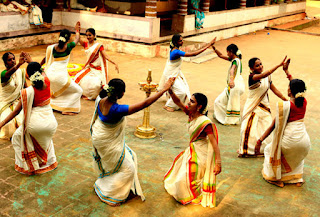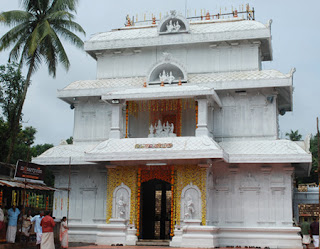Once, the right to perform tantric rituals was rested upon
those who were Brahmins by birth. The time and the history have already proved
that the status of Brahmin, as mentioned in the Hindu epics cannot be attained
by birth. Still many people are reluctant to accept the truth. The effect of
mesmerism, which kept generations under the Brahminical rule, may be the reason
for such a situation.
Here is a legend of Manakkadan Gurukkal, who was a great
tantric and at the same time a great scholar. He was not a Brahmin by birth;
still he could master the art of tantra more than many Brahmins could. This
great man lived in Karivalloor, in Kannur district in the northern Kerala and
was an Ayurvedic physician too.
Many stories of his greatness spread across Kerala and there
were many people who sincerely adored him as a personification of God. This
created jealous in the minds of many people belonging to upper cast, especially
Brahmins. The king of Kolathiri, a princely state existed in Kerala before the independence
of India, planned to test Manakkadan Gurukkal’s expertise in Tantra. King
planned to put Gurukkal to severe test. King and his cohorts believed that
Gurukkal could not pass these tests and so he will get insulted and will run
away from his country.
Actually, Gurukkal was undergoing some bad times in his life
then; still he could not reject the invitation of King as it was an order. He
was sure that he will have to face many hurdles before reaching the palace and
even after reaching there. He prayed to his family goddess and then started his
journey along with his disciple Puthiyodan Nair.
On those days, travelling was not so easy and they had to
travel by walk from Karivalloor and had to cross three rivers before reaching
king’s palace. They started their journey. When they reached near the first
river, they could no see any boats to cross the river. Otherwise there should
be many boats to help the travelers. Gurukkal understood that it was a test put
up by the king. He did not speak anything, instead hold the hands of his
disciple and asked him to close his eyes. Then, Gurukkal performed a particular
tantric ritual known as “Jalasthambham” by which the water in the river stood
still. Both of them walked over it and reached the other bank. Same thing
happened with other two rivers, Pazhayangadi River and Valarpattanam River too.
Finally they reached the palace.
The doors were closed when they reached Palace and there
were no security persons too. It was another test. However, Gurukkal, did not
taken aback. He caught hold of his disciple’s hand tightly and entered inside
the palace with his tantric power. He went through the wall without breaking
it. Once they reached inside the palace, Gurukkal saw many persons sitting on
similar chairs with similar roayal dress. As he did not see the king before,
everybody thought that he will get confused and will bow in front of some one
among those. But Gurukkal identified the real king and bowed in front of him.
Then the king invited him for lunch. All others invited were
belonging to upper casts and as per the system prevailed on those days,
Gurukkal will have to take out the banana leaf which he used as the plate to
have lunch. At the same time, those belong to the upper cast will not have to
take it out as the servants will do for them. Sensing the insult well in
advance, Gurukkal requested to serve the food on the leaf of cucumber and the
same has been agreed. As the lunch is over, the leaf too disappeared. Thus,
Gurukkal won all the tests.
On that evening King and his people enjoyed various
performances done by Gurukkal. After finishing the performance, King gave him a
list and asked to arrange all the forty “Theyyams” (A folk art form) by night.
It was quite impossible for anybody to arrange all those theyyams within a
short period, still Gurukkal did it even without moving out of the palace. Here
the most important thing is that there was no communication facility such as
cell phone etc on those days. When Gurukkal won in that test, King expressed
his desire to visit the heaven and asked Gurukkal to help him. As they were
talking, a rope came down from the sky just behind the king and Gurukkal asked
king to hold it tightly. Slowly the rope went up as if some one is pulling it
from up. Within a short time everybody heard the loud cry of King saying that
he could not withstand the sights and he wanted to come down. Then Gurukkal
brought him down. With that test, King felt that if he continues, it will be he
who will have to eat the pea, hence he stopped testing and send Gurukkal after
honoring him with many awards.
Many years have passed and one day, Gurukkal called his
favorite disciple Puthiyodan Nair and nephews and informed them that it was
time for him to go from this world. He insisted them to constructed an under
ground cell with stone and leave a small hole for air circulation. He also
instructed them to keep his books and pen inside the cell. After that he
entered the cell and asked them to close it. He also asked them to pour water
over the cell for the forty one days. Then cell has been closed after he
entered inside.
Nephews, did according to his direction. On the thirtieth day,
a nephew who was pouring water on the cell developed a curiosity to know what
is happening inside the cell. He peeped through the hole meant for air
circulation and at the same time, pen of Gurukal, which has been kept inside
the cell, came near and pierced his eyes. From that day onwards, no one dared
to go near that cell which exists even today.




















